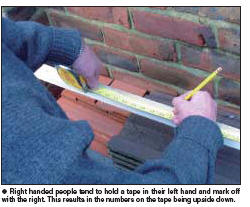 |
 |
 |
 |
 |
 |
 |
|
Check out our web directory of the UK
roofing and cladding industry
www.roofinfo.co.uk |
Sign up for our monthly news letter. |
|
|
|
 The one common tool that every tradesman,
supervisor and designer has in their tool kit is the steel tape measure.
It is used without doubting its accuracy and is trusted by all that use
it. But as a very regular user of the trusty steel tape measure, I am
also aware of its shortcomings that can contribute to inaccuracies in
the setting out of a pitched roof.
Right to left
Statistically the majority of people in the UK are right handed,
therefore it would be natural for them to hold a steel measuring tape in
the left hand and mark off, or note down dimensions, with a pencil or
pen in their right hand. Therefore dimensions tend to be measured
horizontally from right to left. Whilst this method brings the metric
scale to the top edge of the tape, all the numbers are upside down.
Clearly left handed people using the same tape measuring from left to
right have an advantage by having the numbers up the right way, thus
reducing the risk of misinterpretation!
Most interlocking tiles and some accessories
are designed specifically to be laid from right to left, therefore it is
natural to measure and set out a roof from right to left, regardless of
being right or left handed.
Metric or imperial
If you look closely at a steel tape measure you will see that when
the numbers are up the right way, the imperial dimensions are at the top
and the metric dimensions on the bottom. This is due to the fact that
the majority of steel tapes sold have an American origin, where imperial
is still preferred.
Since the whole of the construction industry
converted to metric measure in 1974, and all specifications, literature
and products are produced in metric, why is imperial measurement on the
measuring tape at all? Whilst some roofers set out roofs in metric, the
vast majority still use imperial measurement, due to the practice of
roofing being a trade that is passed down from one generation to the
next. Regardless of colleges teaching metric measurement, site practice
seems to takes precedence.
Dimensional errors
To set out a roof in imperial, technical information from British
Standards, specifications or manufacturers literature has to be
converted from metric into the nearest imperial equivalent. This is
where the first error in setting out a roof begins. A batten gauge of
100mm is 2mm less than 4in, 200mm is 4mm less than 8in, 250mm is 4mm
less than 10in, 300mm is 5mm less than 12in, 340mm is 3mm less than
13.5in and 355mm is 1mm short of 14in.
|
 |
The second error of setting out a roof is
the minimum division used. Most roofers will try and set out to the
nearest quarter inch. If required they will work to an eighth of an
inch, but few will work to a sixteenth of an inch. With metric
measurement most roofers will set out to the nearest 5mm. If they are
required they will set out to 1mm. If we do a very accurate conversion
from imperial to metric, one quarter of an inch is 6.35mm and one
sixteenth of an inch equals 1.587mm. Therefore working only in metric
measurement can be more accurate than converting to imperial to do the
same job.
The third error of setting out is
multiplication and division. Slates and tiles, being small elements,
require a large degree of repetitive measurement. Metric being to the
power of ten makes multiples or divisions of any given dimension far
easier to calculate (especially without a calculator) than imperial
measurements and fractions.
For example, 55 plain tile gauges measured in
metric would be 55 by 100mm =5.5m.
The same calculation in imperial would be 55 by
3 15/16th = 165.00 + (55 - 3 7/16th) = 216 9/16th inches or 18ft 0 &
9/16 inches.
Of the two, the metric calculation is most
definitely the simpler!
Conclusion
Whilst inaccuracies of setting out are not strictly the fault of the
steel measuring tape. The fact that a metric only tape is almost
impossible to buy encourages, rather than discourages, the continued use
of imperial measurement. Roofers' steel measuring tapes should be metric
on both edges with the numbers set so that they can be read easily for
both left and right handed use.
While old habits die hard, adopting metric
measurement for all construction work, including roofing, is far easier
than imperial once learned. It is also more accurate and quicker to
undertake than imperial, and will become more so when steel measuring
tape manufacturers realise that not everybody is left handed or measures
from left to right. |
|
Compiled by Chris Thomas, The Tiled
Roofing Consultancy, 2 Ridlands Grove, Limpsfield Chart, Oxted, Surrey,
RH8 0ST, tel 01883 724774 |
|